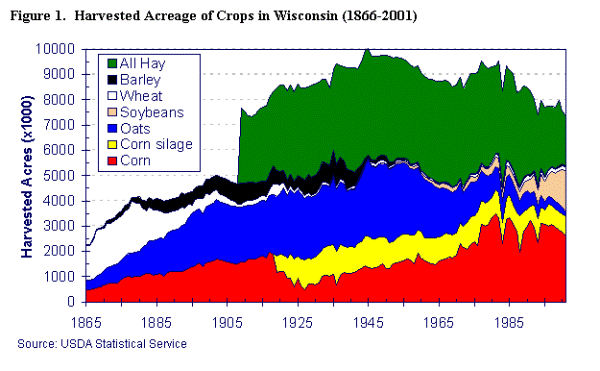The Corn-Soybean Rotation: A "New Kid" on the Block
May 9, 2002 9(8):59-61
Joe Lauer, Corn Agronomist
Within the last farm generation (20 to 30 years) significantly more acreage has
been planted to corn and soybean in Wisconsin and the Midwest U.S. This cropping
system is a relative "new kid on the block." Much discussion is taking place about
whether or not the corn-soybean system can be sustainable. This article is the first
in a series to evaluate crop rotations in Wisconsin. The objective of this article
is to discuss the historical changes that have occurred in Wisconsin cropping systems.
Crop rotation is a management system of growing one or more crops in sequence on
the same piece of land, the sequence being repeated again and again (Cady, 1991).
Rotations can be as simple as monocultures year after year or complex involving
grain crops, forage grasses and legumes, and livestock (Hoeft et al., 2000)
.
The major crops produced in Wisconsin have traditionally supported the dairy and
livestock industries. Corn grown for grain and silage has been an important crop
since 1865 (Figure 1). Wheat was produced on the greatest number of acres between
1865 and the early 1900s after which many farmers were switching to barley and oats.
Oat was produced on a large proportion of acres until tractors came into widespread
use in the 1940's. The addition of soybean to Wisconsin agriculture is relatively
recent. It wasn't until the late 1970's that soybean acreage approached 300,000
acres. By 1997 soybean was produced on 1 million acres.
It is difficult to get a handle on how fast crop sequences are rotated through time.
One approach to measuring how fast crops are rotated is to add the acreages of crops
together and calculate the proportion of acres relative to the total cropland available.
If two crops are grown on more than 90% of the cropland available, then the rotation
sequence is limited to those crops with some acres in continuous monoculture production,
most of the acreage rotated between the two crops, and the balance to miscellaneous
crops. When the total proportion of two crops is >85% of the total cropland,
nearly all of the land is used for production of those two crops and little crop
diversification exists.
In 1972 only Piatt County in central Illinois had 75-85% of its total cropland in
corn and soybean (Figure 2). By 1998, many counties in the Midwest U.S. have 75-85%
of the total cropland in corn and soybean. A total of 26 counties have more than
85% cropland in corn and soybean.
The first county in Wisconsin to have more than 85% of its cropland in corn and
soybean was Rock County during 2001 (derived from USDA Statistics).
The southern two tiers of counties in Wisconsin have traditionally had a large proportion
of acres in corn and soybean, and recently more acres are increasing towards the
northeast.
Clearly the crop sequence landscape has changed dramatically from a generation ago.
Certainly years like the winter of 2000-2001 when natural gas prices rose to record
levels, nitrogen fertilizer was in great demand and prospects loomed for growing
soybean in the same fields for two (really three) years forced many growers to reevaluate
their crop rotations. This situation may or may not be sustainable, but greater
risk to the farmer may be a consequence of these rotations and needs to be considered
for crop management. Next week's article will be on "What have we learned about
crop rotation?"
Literature Cited
Cady, F. B. 1991. Experimental design and data management of rotation experiments.
Agronomy Journal 83:50-56.
Hoeft, R. G., Nafziger, E. D., Johnson, R. R., and Aldrich, S. R. 2000. Modern
corn and soybean production. First edition. MCSP Publications. Champaign, IL.

